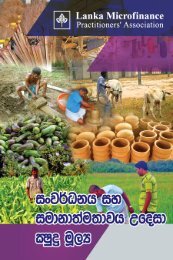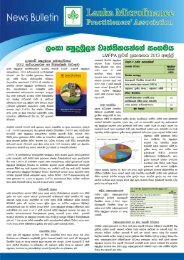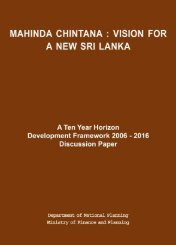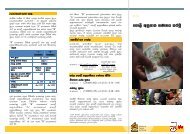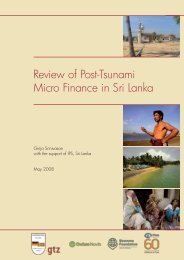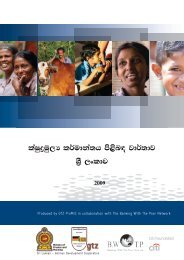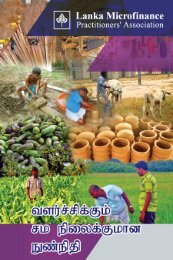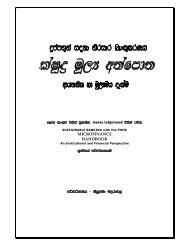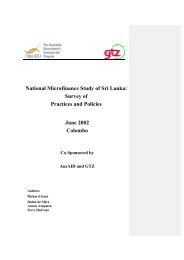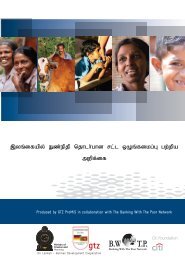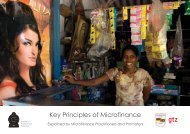Microfinance Industry Report SRI LANKA - Microfinance in Sri Lanka
Microfinance Industry Report SRI LANKA - Microfinance in Sri Lanka
Microfinance Industry Report SRI LANKA - Microfinance in Sri Lanka
You also want an ePaper? Increase the reach of your titles
YUMPU automatically turns print PDFs into web optimized ePapers that Google loves.
6. Access to F<strong>in</strong>ancial Services<br />
The follow<strong>in</strong>g is based on a survey of approximately<br />
3,000 households across 22 districts of <strong>Sri</strong> <strong>Lanka</strong> <strong>in</strong><br />
2007 17 . The results of the survey <strong>in</strong>dicate that 82.5% of<br />
households have obta<strong>in</strong>ed f<strong>in</strong>ancial services from FIs,<br />
by deposit<strong>in</strong>g their sav<strong>in</strong>gs <strong>in</strong> an FI and/or obta<strong>in</strong><strong>in</strong>g<br />
a loan from an FI. Further, nearly 50% of households<br />
have accessed multiple FIs for their f<strong>in</strong>ancial needs.<br />
The utilization of sav<strong>in</strong>gs facilities is considerably<br />
higher than the utilization of credit – nearly 75% of<br />
households have saved with an FI compared to only<br />
47% of households hav<strong>in</strong>g obta<strong>in</strong>ed loans from an<br />
FI. The former is confirmation of the strong sav<strong>in</strong>gs<br />
culture <strong>in</strong> the country.<br />
However, the overall figures hide the disparities<br />
which exist at various levels. In the estate sector,<br />
25% of households have not utilized the services of<br />
an FI compared to 17.5% and 15% of rural and urban<br />
households respectively.<br />
Type of Institution Accessed<br />
The state banks play a key role <strong>in</strong> provid<strong>in</strong>g f<strong>in</strong>ancial<br />
services. It was found that 72% of households which<br />
had utilized the services of FIs had accessed the<br />
state banks. The People’s Bank, <strong>in</strong> particular, plays<br />
a dom<strong>in</strong>ant role <strong>in</strong> this regard. Domestic private<br />
banks have been accessed by 30% of households<br />
utiliz<strong>in</strong>g f<strong>in</strong>ancial services and <strong>in</strong>terest<strong>in</strong>gly, 25% of<br />
households which have utilized f<strong>in</strong>ancial services<br />
have done so through the Samurdhi Bank Societies<br />
(SBSs). S<strong>in</strong>ce the SBSs are essentially microf<strong>in</strong>ance<br />
<strong>in</strong>stitutions target<strong>in</strong>g very low <strong>in</strong>come households,<br />
this is an <strong>in</strong>dication of the outreach of microf<strong>in</strong>ance.<br />
The outreach of microcredit is also evident <strong>in</strong> the fact<br />
that a higher proportion of households who have<br />
obta<strong>in</strong>ed loans from an FI, have obta<strong>in</strong>ed them from<br />
MFIs such as the RDBs, SBSs, Sanasa and NGO-MFIs,<br />
17 The survey was conducted for GTZ-ProMiS (Promotion of the<br />
<strong>Microf<strong>in</strong>ance</strong> Sector) by the Institute of Policy Studies (IPS), <strong>Sri</strong><br />
<strong>Lanka</strong>. The objective of the survey was to assess the extent of<br />
utilization of f<strong>in</strong>ancial services offered by formal and semiformal<br />
f<strong>in</strong>ancial <strong>in</strong>stitutions (FIs) <strong>in</strong> <strong>Sri</strong> <strong>Lanka</strong>, with a special focus<br />
on microf<strong>in</strong>ance services. The def<strong>in</strong>ition of FIs for the survey,<br />
encompassed not only commercial banks, f<strong>in</strong>ance companies<br />
and leas<strong>in</strong>g companies but also CRBs, Samurdhi Bank Societies<br />
and NGO-MFIs.<br />
The districts of Kil<strong>in</strong>ochchi, Mannar and Mullaitivu <strong>in</strong> the<br />
Northern Prov<strong>in</strong>ce could not be covered due to the prevail<strong>in</strong>g<br />
conflict situation <strong>in</strong> the area.<br />
compared to the domestic private banks and foreign<br />
banks. Interest<strong>in</strong>gly, 26% of households with loans<br />
have obta<strong>in</strong>ed them through the SBSs. However, the<br />
state banks as a group rema<strong>in</strong> the largest provider<br />
of credit, with People’s Bank be<strong>in</strong>g the dom<strong>in</strong>ant<br />
<strong>in</strong>stitution. The CRBs, despite a large network of<br />
outlets, seem to play a relatively less significant role.<br />
Only 5% of households who have obta<strong>in</strong>ed loans<br />
have accessed the CRBs for this purpose.<br />
With regard to sav<strong>in</strong>gs, aga<strong>in</strong> the state banks<br />
dom<strong>in</strong>ate, particularly the People’s Bank (48% of<br />
households with sav<strong>in</strong>gs) and also to a lesser extent,<br />
the Bank of Ceylon (36% of households with sav<strong>in</strong>gs).<br />
The domestic private banks also play a significant<br />
role (utilized by 30% of households with sav<strong>in</strong>gs) as<br />
do the SBSs (21% of households with sav<strong>in</strong>gs) and<br />
RDBs (12% of households with sav<strong>in</strong>gs).<br />
Borrow<strong>in</strong>gs and Sav<strong>in</strong>gs of<br />
Households<br />
The average loan size for a household dur<strong>in</strong>g the 3<br />
years preced<strong>in</strong>g the survey is less than Rs.100,000 (c.<br />
Rs. 84,000). Over 80% of households have borrow<strong>in</strong>gs<br />
not exceed<strong>in</strong>g Rs. 100,000. However, there are<br />
marked differences across sectors and regions. In<br />
the estate sector, over 87% of households have<br />
borrow<strong>in</strong>gs below Rs. 50,000. Average loan size <strong>in</strong> an<br />
urban household is more than 10 times the average<br />
loan size <strong>in</strong> the estate sector and more than twice<br />
that of a rural household. Similarly, <strong>in</strong> the relatively<br />
more affluent Western Prov<strong>in</strong>ce, average loan size is<br />
c. Rs 162,000, almost twice the national average and<br />
almost 6 times higher than <strong>in</strong> the predom<strong>in</strong>antly<br />
agricultural North Central Prov<strong>in</strong>ce where the<br />
average loan size is around Rs. 27,000.<br />
Over 80% of households have sav<strong>in</strong>gs of less than Rs.<br />
50,000. The national average is c. Rs. 22,000. However,<br />
the disparities at the sectoral level are not as large as<br />
<strong>in</strong> the case of loans. The average sav<strong>in</strong>gs of an urban<br />
household is around twice the national and rural<br />
averages and four times that of an estate household.<br />
However, s<strong>in</strong>ce the sav<strong>in</strong>gs here represent f<strong>in</strong>ancial<br />
sav<strong>in</strong>gs and estate households could be sav<strong>in</strong>g<br />
<strong>in</strong> other forms (e.g. jewellery), sav<strong>in</strong>gs picture for<br />
Bank<strong>in</strong>g With The Poor Network 19




